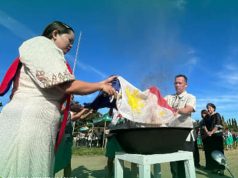
The Philippines is celebrating Independence Day on Wednesday, June 12 and many institutions displayed the country’s flags to commemorate the occasion.
The secretariat of the Association of Southeast Asian Nations, which the Philippines co-founded in the 1960s, similarly released a photograph on Facebook to greet the country on the day marking its freedom from Spain 121 years ago
“Happy Independence Day to our friends in the Philippines! Also known as Araw ng Kalayaan—Day of Freedom, 12 June is observed with ceremonies and parades by the government, armed forces and different ethnic groups to commemorate the country’s declaration of independence from Spain,” the 10-member bloc said on its Facebook account.

The caption as accompanied by a photo of four smiling individuals holding up small Philippine flags, but they are also partially covered by a larger Philippine flag that is upside down.
Traditionally, however, when the red portion of the flag is placed above the blue, it indicates that the country is in a state of war.
The comments thread below the post were soon flooded with reminders from Filipinos.
“Thanks for the greetings. But ASEAN, I think the flag is positioned in a wrong manner,” a Facebook user commented.
“Please change the picture… not happy it is displayed that way in this special occasion,” wrote another.
The ASEAN Facebook account shortly deleted the post.
The mistake, while considered a major faux pas to many Filipinos, is not altogether avoidable abroad where national flags normally do not serve a function to signal a state of war or peace.
In 2010, the United States apologized to the Philippines for flying an inverted flag at an event where then American President Barack Obama met with then Philippine President Noynoy Aquino.
Rich in history, unique in design
The Philippine flag was flown throughout the Filipino Revolutionary War with the red block on top to denote a state of war. It was first unfurled as a revolutionary standard in a battle against Spanish troops in Alapan, Cavite in May 1898, as stated in records from the Presidential Museum.
General Emilio Aguinaldo, a revolutionary leader, later explained the flag’s feature in a letter to Captain Emmanuel Baja in June 1925:
“Several press representatives called on me then to inquire as to how the Flag should be flown. I answered them that it should be always hoisted with the blue stripe up in time of peace. But on the battlefields and in camps during the past war, first with Spain and then with the United States of America later, our National Flag had been hoisted with the red stripe up.”
The Philippine flag is the only national standard in the world that is inverted during wartime.









